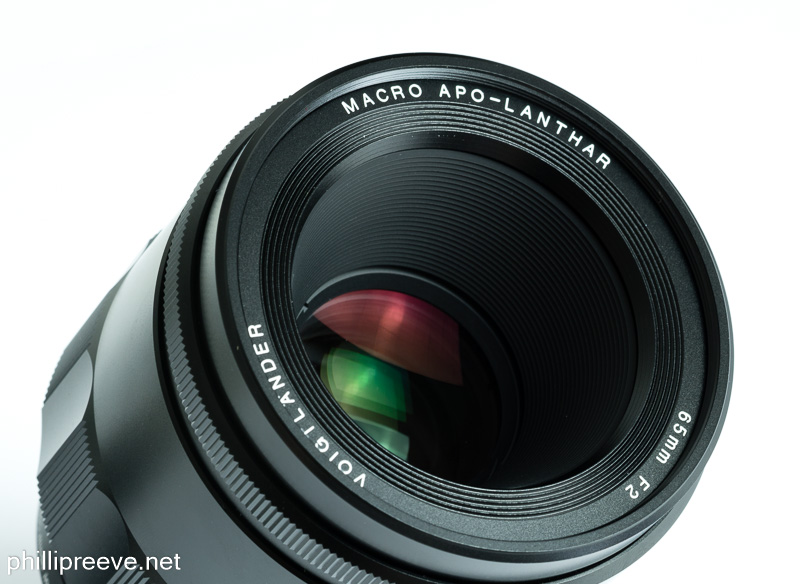
The Voigtlander 65mm F2 Macro APO-Lanthar is the second APO branded E-mount lens and promises great image qualities as well as macro capabilities in an unusual focal length. In this review I evaluate whether the high price and relatively large size are worth it.
Image Samples
You can find all images shown in this image in full resolution in this album.
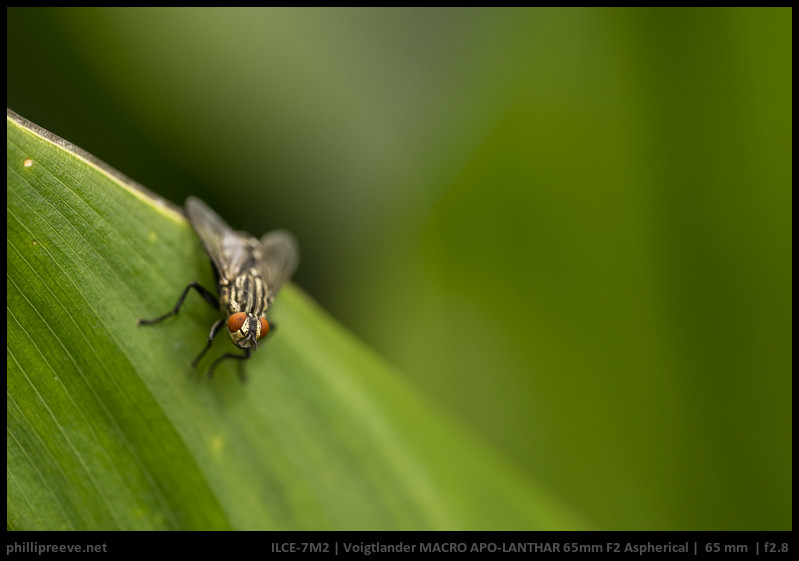
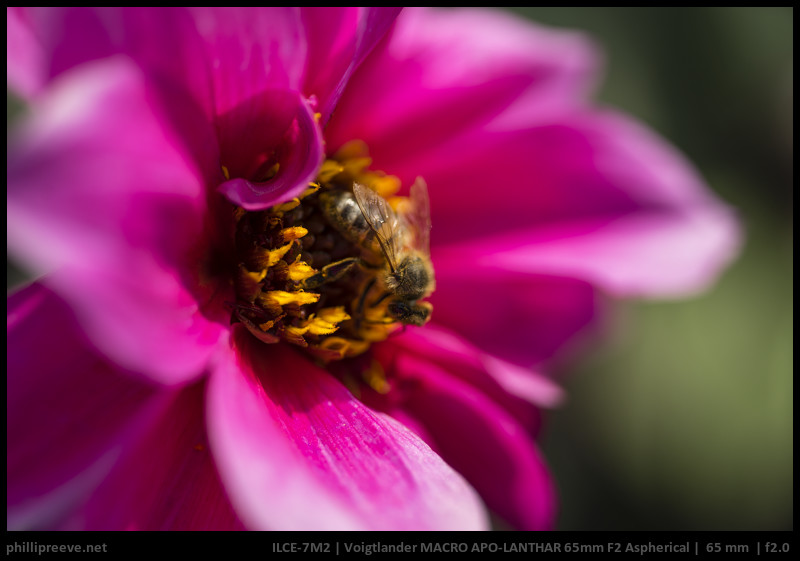

Specifications
| Diameter | 78 mm |
| Length | 91 mm |
| Filter Thread | 67 mm |
| Weight | 635 g |
| Max. Magnification | 0.5 |
| Close Focusing Distance from the sensor | 0.31 m |
| Number of aperture blades | 10 |
| Elements/ Groups | 10/8 |
Disclosure
A copy of the 2/65 APO was loaned to me from Voigtlander’s German distributor ringfoto.de for a few weeks. After that I bought my own copy at full retail price.
Features
The Voigtlander 65mm F2 Macro APO-Lanthar is a fully manual lens so you have to change focus and aperture by yourself. The camera can’t change the aperture so S- and P-mode will not work as with native lenses.
It has electronic contacts to communicate with the camera. The lens provides correct exif-data and distance information so that 5-axis OSS can be used. Focus magnification can be automatically activated when the focus ring gets turned.
The Voigtländer carries the Macro tag but unlike most other modern Macros like the Sony FE 2.8/50 Macro it only reaches a magnification ratio of 1:2. This is quite usual for a manual lens which does not focus internally, it would need to have a very large helicoid otherwise.
Voigtlander also calls it an APO lens which means that chromatic aberrations are very well corrected. More on this further below.
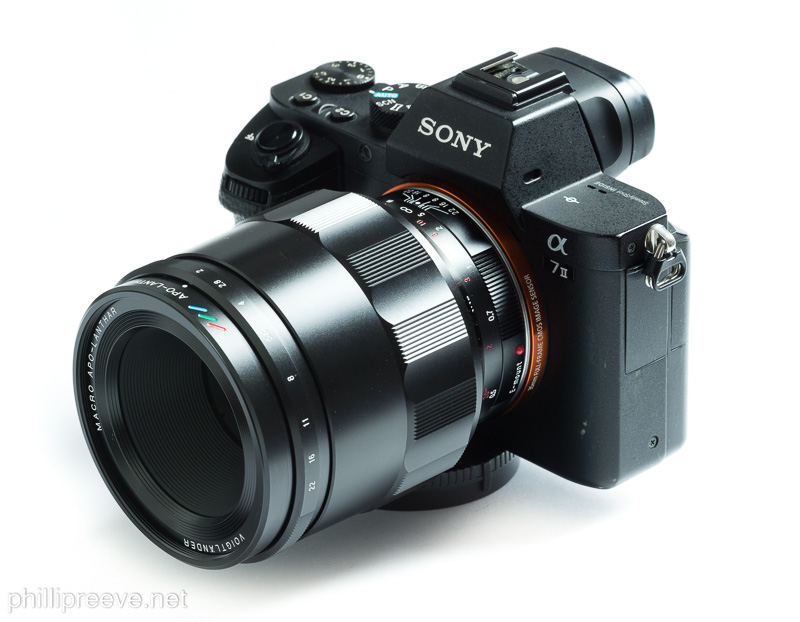
Build quality and handling
The Voigtlander 65mm F2 Macro offers very good build quality. The lens hull is made from nothing but metal and tolerances are very low. Most but not all markings are engraved.
There is no gasket around the mount and Voigtlander does not claim any weather resistance.
Of course I can’t tell you how durable the lens will be in the long term. All I can do is give you my superficial impression which is very positive in this case.
Our experience with getting Voigtlander lenses repaired is not the best though, the lens had to be shipped to Japan so the repair took two months.
Handling
If you have used Zeiss Loxia lenses you will probably have been frustrated by the fact that there is no good place to grab them when you change lenses. This is not an issue with the Voigtlander since you can easily grab it by its base which is even textured for better grip.
Focus Ring
The focus ring travels around 250 degrees from 31 cm to 1 m and a further 40 degrees to infinity. I think that is a very reasonable transmission for a macro but it is a bit slower to focus precisely at longer distances. The ring itself is easy to grip and the resistance is about perfect.
Aperture ring
The aperture ring is a joy to use. It is made from metal with distinctive stops and a very pleasant resistance. I am not a fan of 1/3 stops but apart from that it is great. The Voigtlander stops down to f/22.
Hood
The Voigtlander 65mm F2 Macro has a deeply recessed front element so I see no reason for a hood but none the less it comes with a small hood made from metal.
Size and Weight
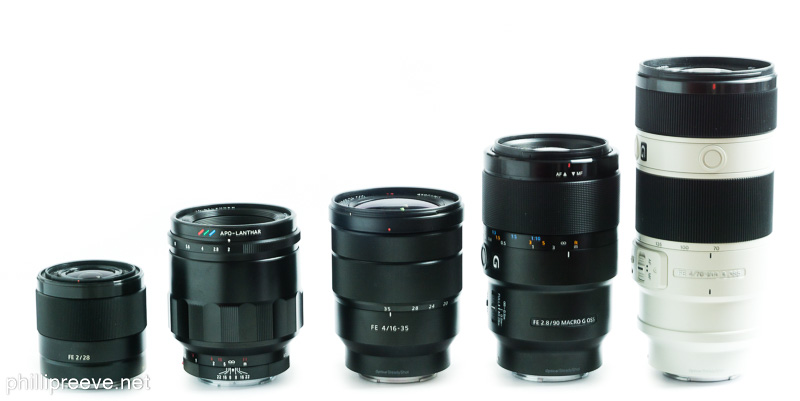
This is not an internally focusing lens so it extends a lot when focused at 1:2.
The CV 2/65 is a substantial lens. In my experience so far handling is still pleasant but many smaller lenses feel better matched with my a7ii. In light of the great performance this is not a big issue but something to consider when you decide whether to purchase the lens.
Optical performance
These results are based on the use with a Sony Alpha 7II.
Flare Resistance
When pushed very hard the Voigtlander will show ghosting, some veiling flare and an unusually high amount of sensor reflections at least on my a7ii.
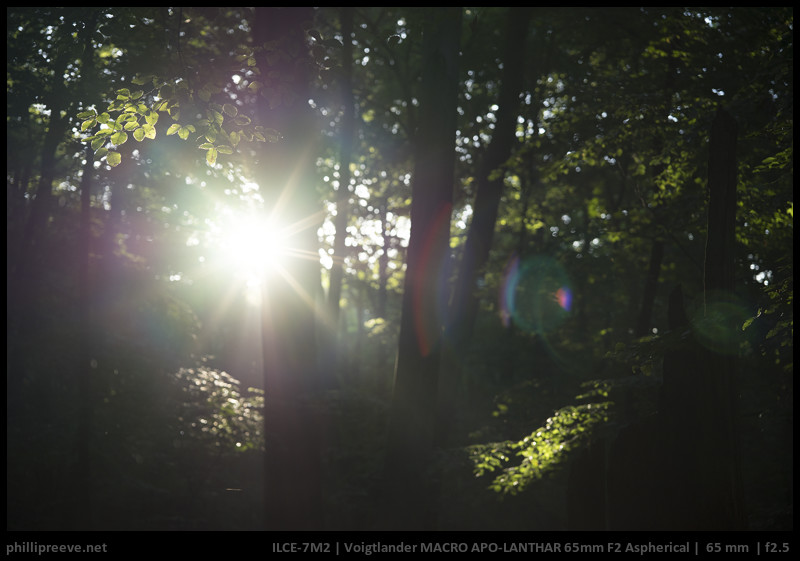
I made the image above early in my rolling review and it lead to me rating the lens average in this aspect. Since then I have had a closer look at the flare resistance and usually it performed well even in demanding scenarios so now I would rate it quite good actually.
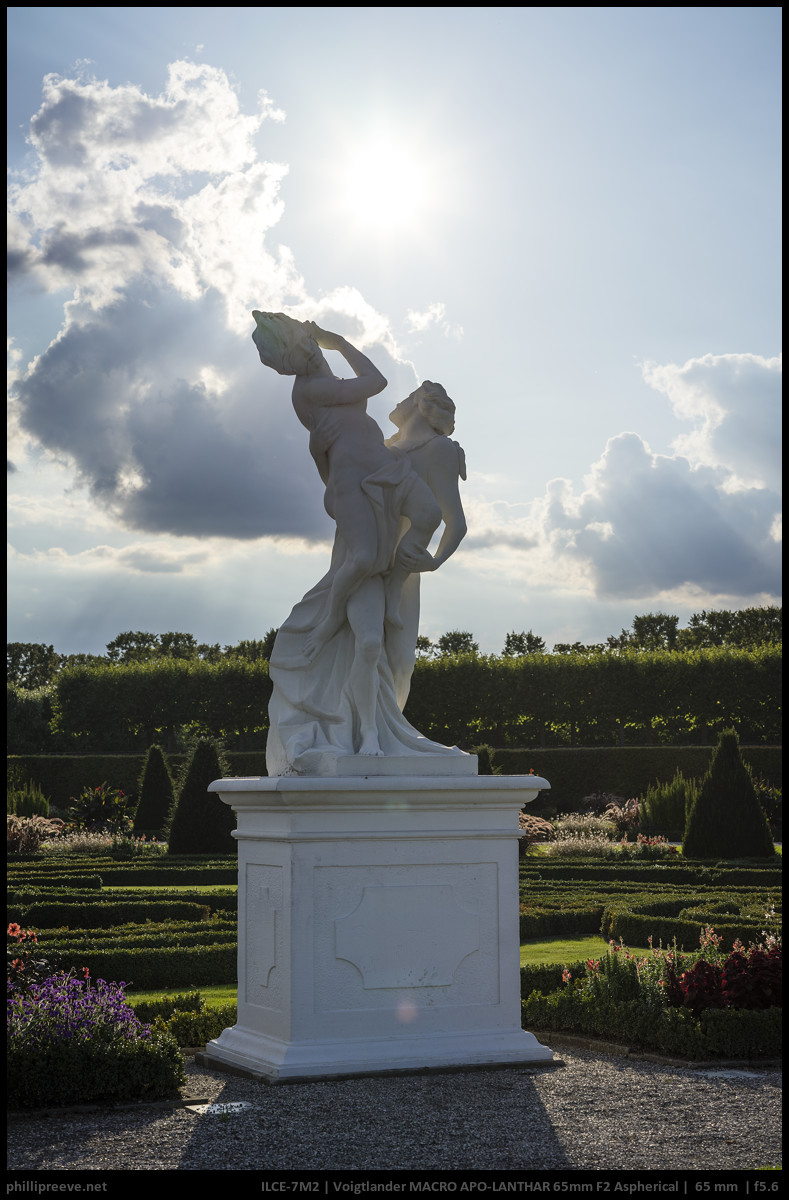
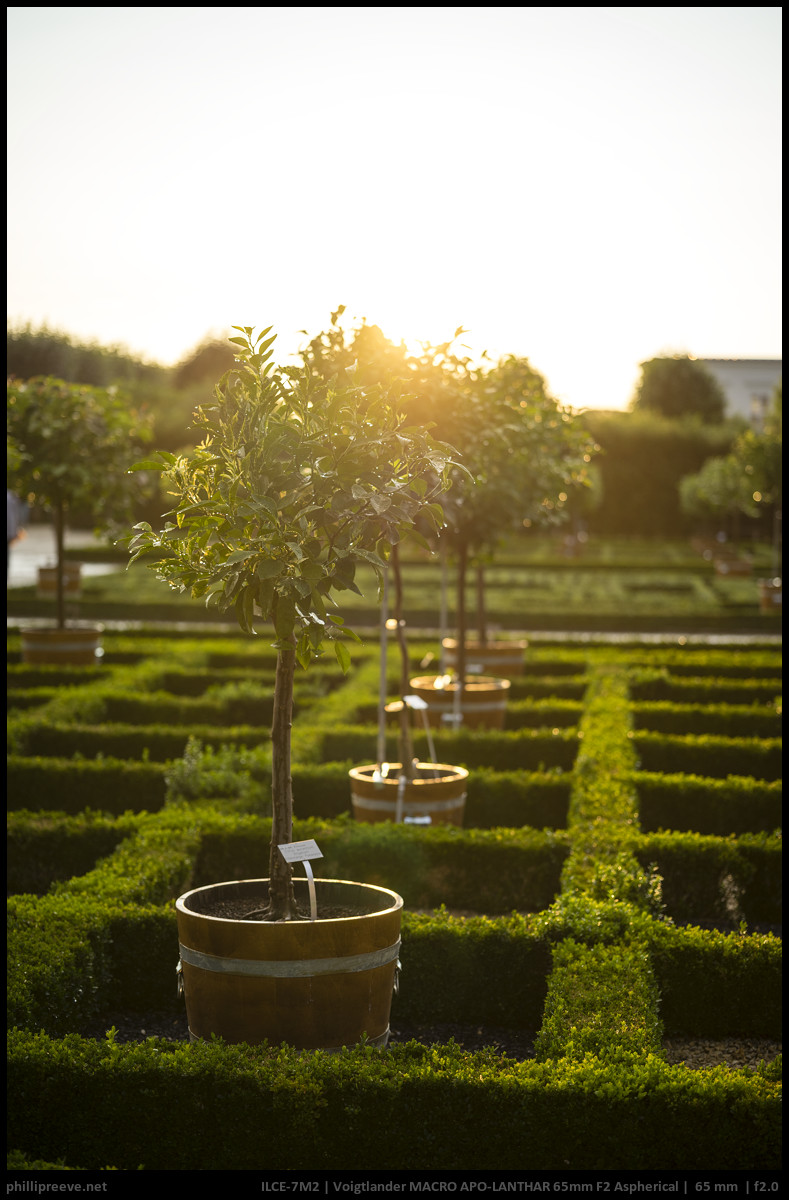
Sunstars
Voigtlander lenses are known for their very defined 10-pointed sunstars. Personally I like this effect a lot, other people don’t. You just need to stop down to f/2.5 until they are very well defined.
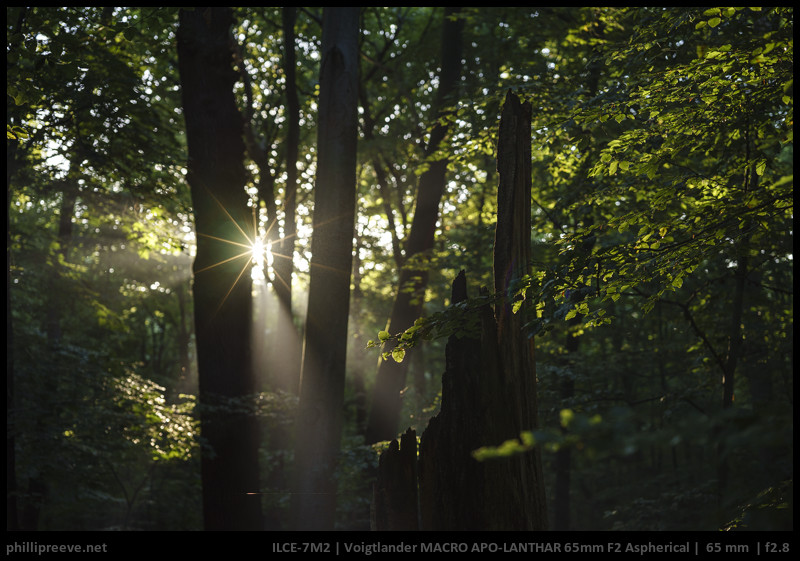
Bokeh
Overal I would rate the Voigtlander’s bokeh positive but let’s have a closer look.
Wide open at f/2 it is nearly as smooth as that of the FE55 which in my eyes has one of the smoothest bokehs in any normal lens but the APO-Macro has a lot less bokeh fringing. As usual bokeh is the smoothest at close distances and deteriorates a bit as you focus further.
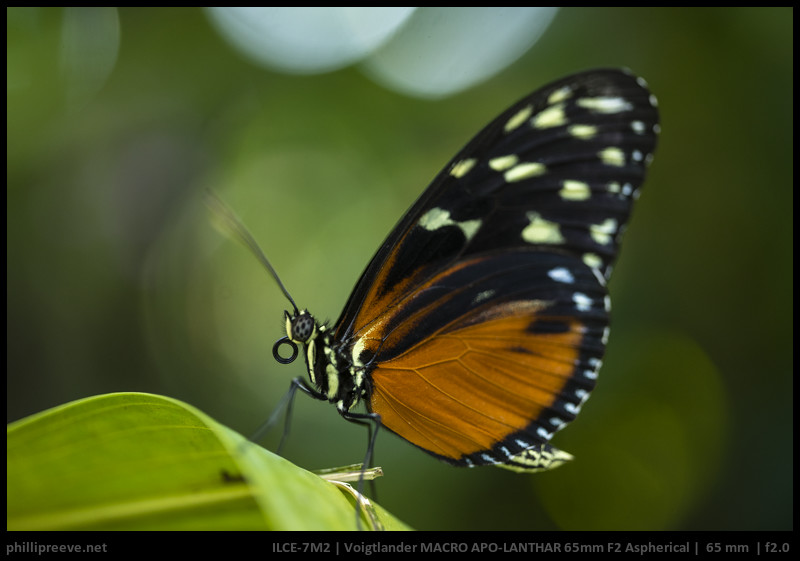
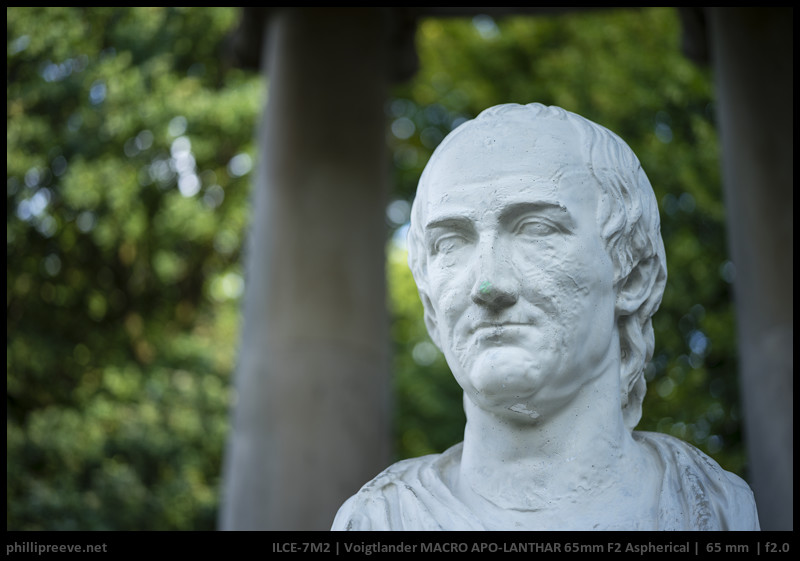
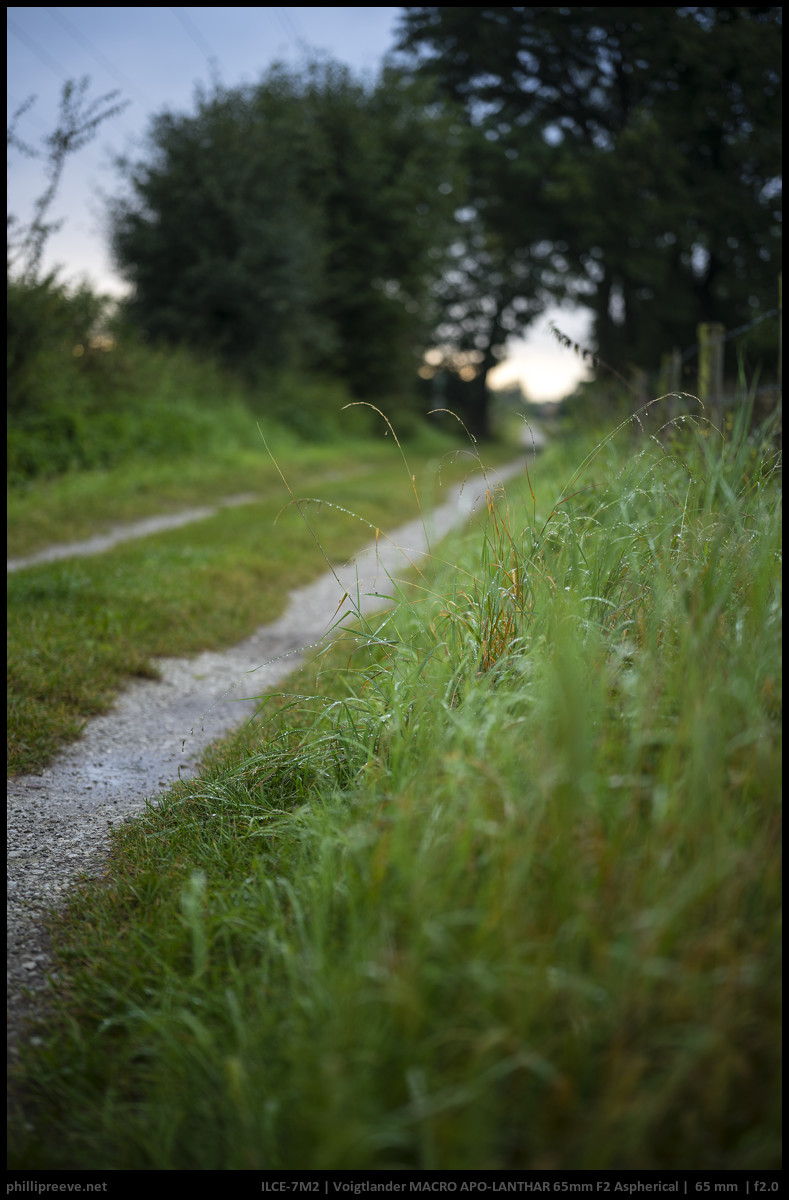
The transition zone is neither good nor bad:
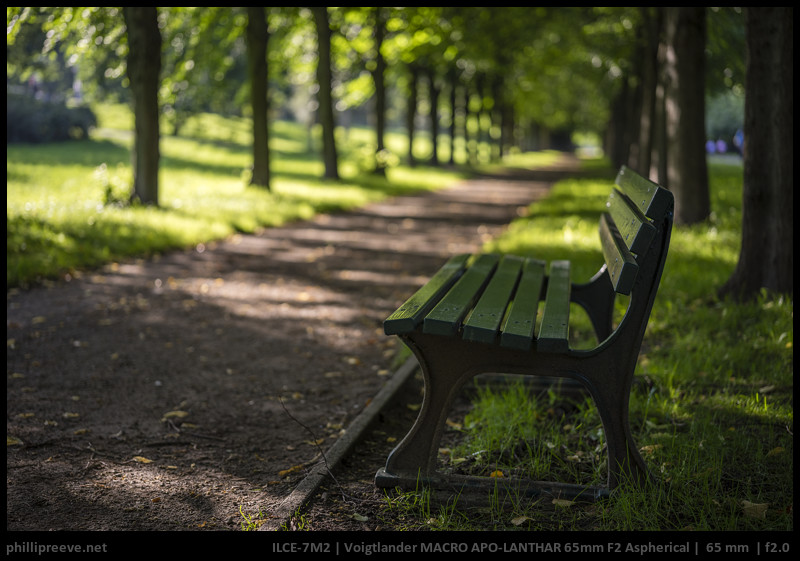
Cat eyes are quite pronounced and there are minor onion rings:
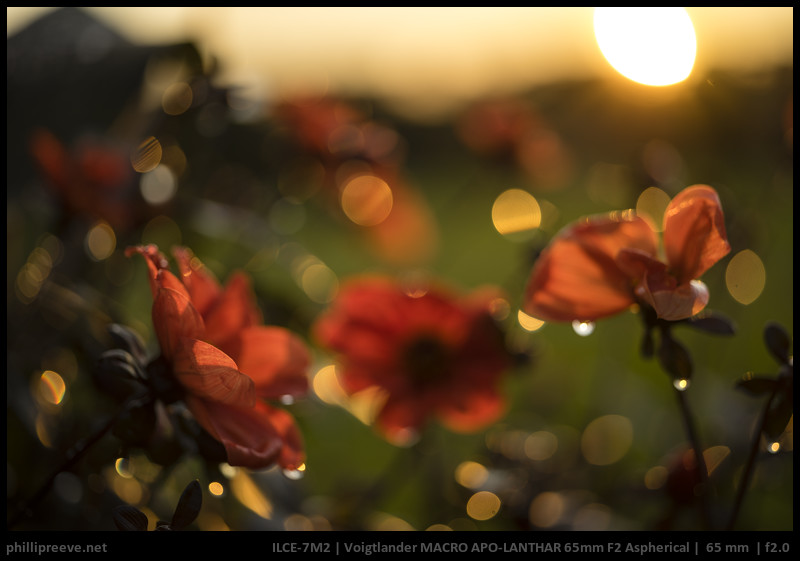
Stopped down beyond f/2 the aperture shape becomes visible because the Voigtlander has straight aperture blades. This can be annoying especially if you have a high contrast background or it can be of little consequence if your background has less contrast. It is also less noticeable as the oof-highlights get smaller as you stop down.
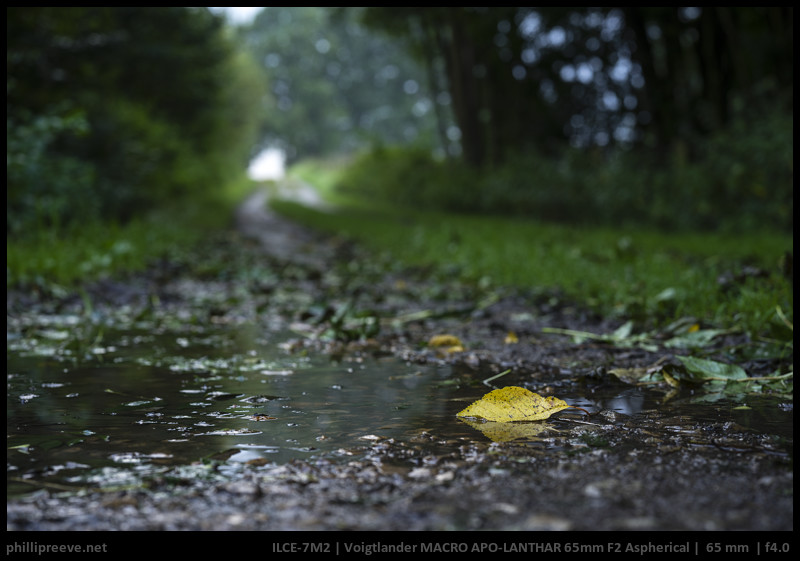
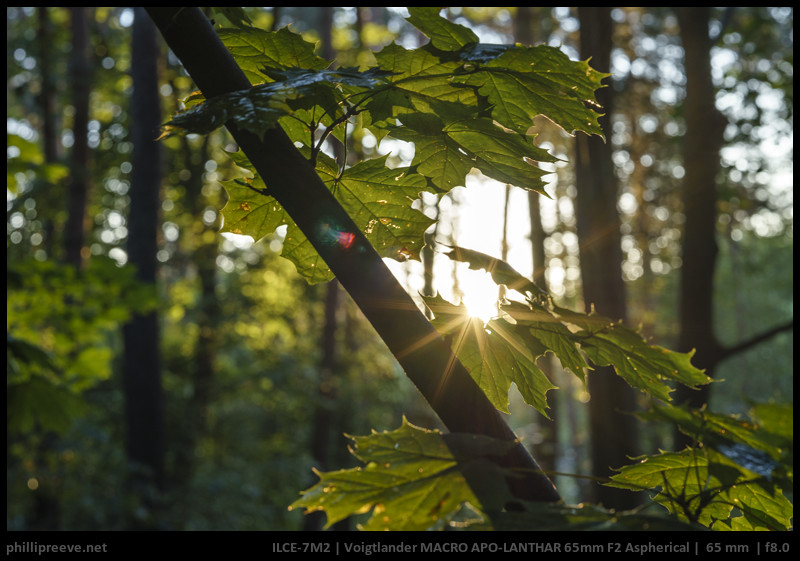
So most of the time the Voigtlander has pretty good bokeh but there are a few situations where it isn’t that good.
Chromatic Aberrations
Since the apochromatic correction is one of the more unusual features of the lens and because not all lenses which are called APO offer exceptional CA correction I was curious how the Voigtlander APO 2/65 would fare.
In short: It lived up to my expectation to the fullest. Optically I was pretty impressed by the FE 1.8/55 except that it showed a lot of axial CA and spherochromatism. The 2/65 APO in contrast shows almost zero CA, even in a worst-case-scenario as backlit water fountain.
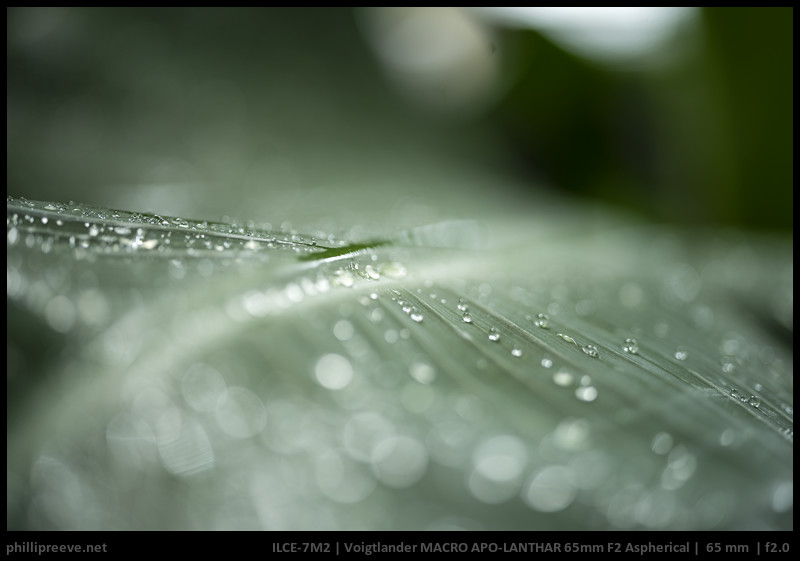
Vignetting
Vignetting at f/2 is 2 stops which is quite a bit and easily visible if uncorrected. Stopping down to f/2.8 reduces it to 1.2 stops which are still noticeable. At f/4 vignetting is hardly noticeable at 0.7 stops and at f/5.6 I measure 0.6 stops:
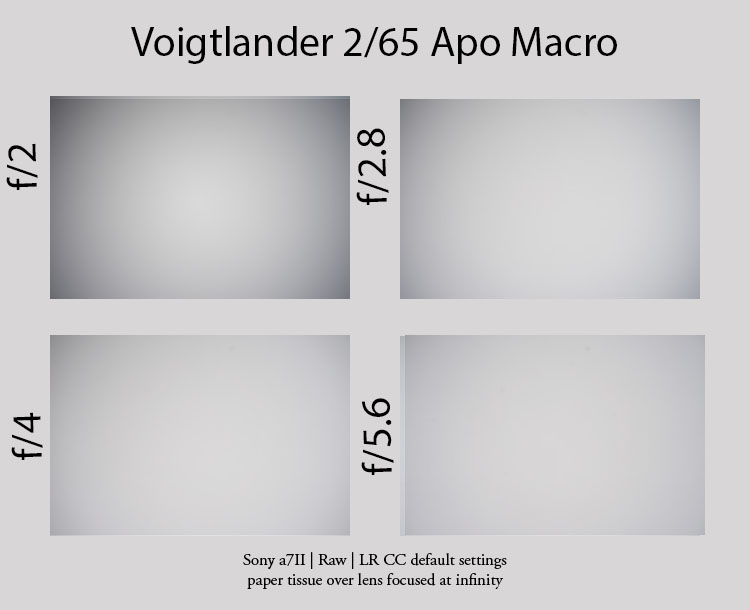
Distortion
The Voigtlander 65 mm F2 Macro shows no visible distortion. That is not unusual for a macro but still an achievement.
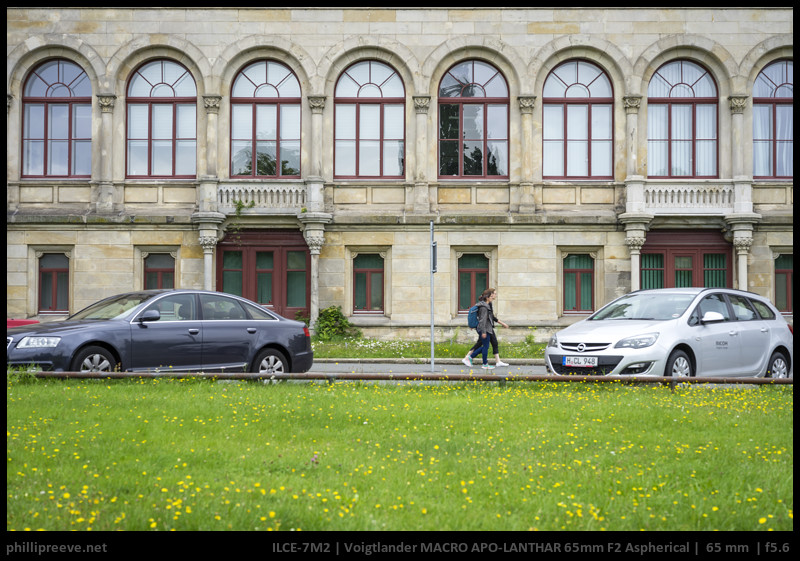
Sharpness
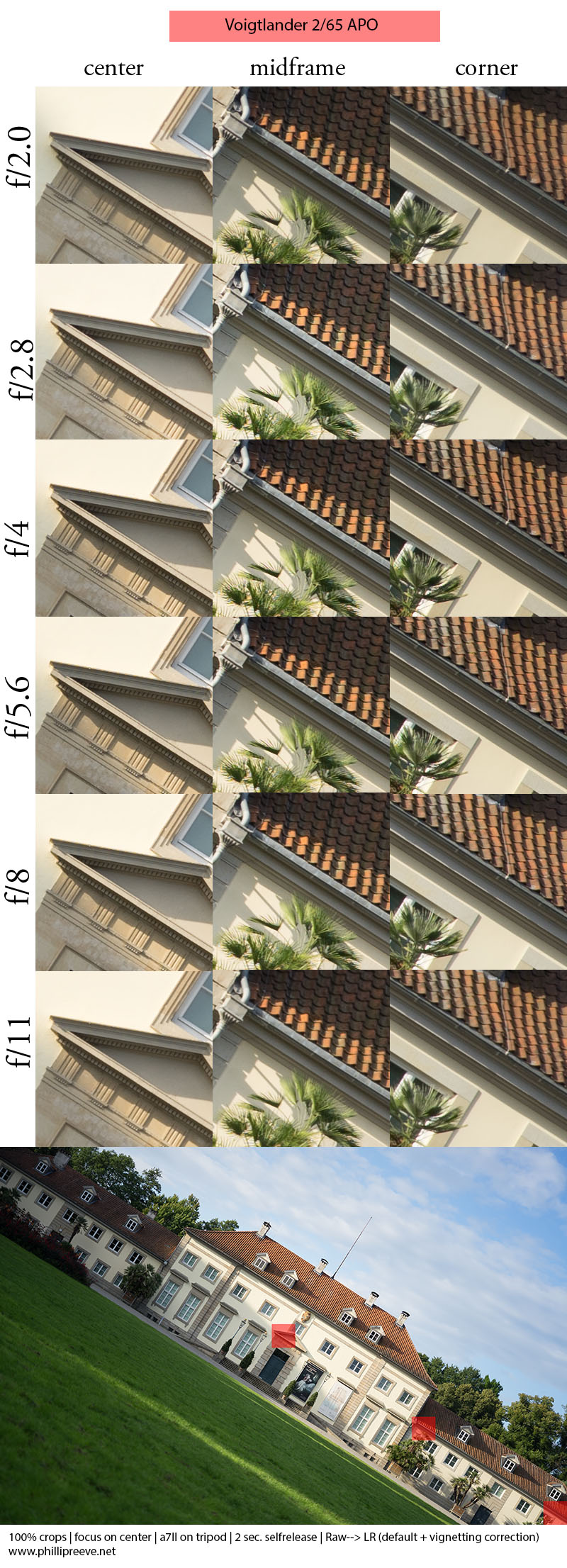
Just wow! I have never before tested a lens with such great results. The Voigtlander 2/65 APO is excellent across the frame from wide open with only the slightest bit of falloff towards the corners.
At 1:2 the Voigtlander 2/65 is also a great performer, I think it is a tad less sharp at f/2 though.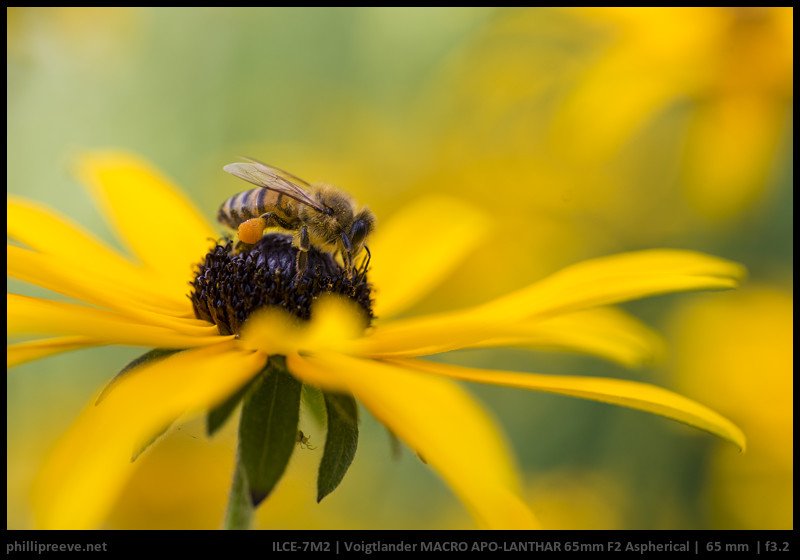

Alternatives
65 mm is a rather unusual focal length so I have to interpret the term alternative a bit more loosely here.
Sony FE 2.8/90 Macro: Of course the focal length is quite different but apart from that I found the Voigtlander a tad sharper at longer distances and both lenses similarly sharp at shorter distances. The Sony has smoother bokeh, especially in the transition zone. The Sony offers pretty good CA correction but it does not reach the perfection of the Voigtlander. The Sony of course offers AF and 1:1 but I find the manual focus rather sluggish and I also prefer the handling of the more compact and much more solid feeling Voigtlander. Another advantage of the Voigtlander are the very nice sunstars which come at the cost of stopped down bokeh. If your focus is on macro photography the Sony makes more sense.
602 g | $998 | amazon.com (affilate link)
Sony FE 2.8/50 Macro: The much smaller, cheaper and slower Sony lens can reach a higher magnification ratio of 1:1 but I think the Voigtlander is the more universal lens since it is faster and better corrected. Optically the Voigtlander is superior because it is sharp in the corners from f/2 with no CA but the Sony is a bit more flare resistant. Manual focus on the Voigtlander is much more pleasant than with the Sony which has a very indirect transmission.
If your focus is on macro or light weight the Sony might be the better option but I found it very slow AF frustrating and the 7 aperture blades can be an issue.
My review | 236 g | $448 | at amazon.com (affiliate link)
Sony FE 1.8/55: The Sony is a damm fine lens with only a tad smoother bokeh (although with much more CA and onion rings). The only aberration which I found at times annoying was the axial CA which is a no-issue with the Voigtlander. The Voigtlander is a tad sharper in the corners at wider apertures but both perform on a very high level here. The most important argument for the Sony I see is the fast AF and the fact that it weights not half as much. The Voigtlander focuses much closer and is build much more solid with great manual focu so personally I prefer the Voigtlander.
My review | my comparison | 281g | $898 | amazon.com (affiliate link)
Tokina 2.5/90 Macro: The nicest legacy macro-lens I have come across so far. It is very sharp in the center from f/2.5 but needs f/5.6 for great corners and it also shows CA at times. Its biggest disadvantage is the weak flare resistance. Bokeh of the Tokina is a bit smoother. A more affordable alternative which does not offer the perfection of the Voigtlander.
My review | 530 g + adapter | about $300 used | at ebay.com (affiliate link)
Zeiss Macro Planar 2/100: Now I am streching it because the Zeiss is a very different focal length but both are modern high performance manual macros. The Zeiss is a bit larger and heavier (with adapter) but not by much. In the end I sold it because I was too bothered by the high amount of axial CA which outweighed its otherwise awesome performance. Now the Voigtlander overcomes that issue and I find it the much more convenient lens.
MTF-data | review | 660 g + adapter | about $750 used | at ebay.com (affiliate link)
Sigma AF 2.8/70: Optically a great lens which approaches the Voigtlanders performance you loose one stop and more importantly the ease of handling because the manual focus is not as pleasant as that of the Sony. With the right adapter it also offers AF though not as nice as that of native lenses. A good choice if performance and value are your biggest concerns and you are willing to sacrifice some ease of use.
Photozone.de review | 525 g + adapter | $ 220 | ebay.com (affiliate link)
Legacy 50/60mm Macro lenses: Lenses like the Nikon Ai-S 2.8/55 can be had for a fraction of the cost and they usually perform quite well although not as exceptional as the Voigtlander 2/65. They are usually smaller and lighter and some even do 1:1. With the exception of a Olympus 2/50 they are not as fast though which to me would limit their use as a standard lens.
Conclusion
pros
|
average
|
cons
|
I think I haven’t found so little fault with a lens before. The Voigtlander Macro 65mm F2 APO-Lanthar shows excellent sharpness from f/2 across the frame. It also does the APO-label justice since its CA correction is close to perfect. Neither is there any distortion. Bokeh is smooth most of the time but cat-eyes can be a bit distracting as can be the straight aperture blades. Only vignetting is on the higher side but that is a small price to pay for this exceptional performance. In my eyes it is optically the best E-mount lens at the moment, together with the Batis 2.8/135.
The Voigtlander is a rather large and heavy lens, especially if you compare it with the smaller and much lighter FE 1.8/55 so to enjoy its performance you have to put up with the weight. I would probably leave it at home for a hiking trip but for my everyday use I am happy to carry a little more for that level of performance. Handling is close to perfect for a manual lens with a very nice focusing ring and excellent build quality.
So who should buy this lens? I think the Voigtlander APO 2/65 is an interesting amalgam of the classic 50mm and 85mm lens, still wide enough to function as a normal lens but with a bit more compression for undistorted portraits. I think it works great in a kit with a 35mm and 135mm lens. The 1:2 macro function and the superior performance is a clear advantage over classic normal lenses but I don’t think that it is great choice if your focus is on macro since it doesn’t get that close and you would probably want something longer for that. Manual focus will be an issue for some, for me it is a bonus. I can’t say that I enjoy the large size but for the level of perfection it is a small price to pay.
All in all I have never before been that impressed by a lens. The Voigtlander APO Macro 2/65 delivers a nearly flawless performance. For me this is the optically best E-mount lens at the moment, only rivaled by the Zeiss Batis 2.8/135. It is quite large but the handling is a joy if you like manual lenses. The price is quite low compared to lenses of similar performance but of course still high in absolute terms.
The Voigtlander 2/65 APO-Macro sells for $999 at CameraQuest, amazon.com or ebay.com, 999€ at ebay.de (affiliate links).
If this review was helpful to you, please consider using one of my affiliate links. Thanks ?
More Image Samples
You can find these more images in full resolution in this flickr set: Voigtlander 2/65 APO.
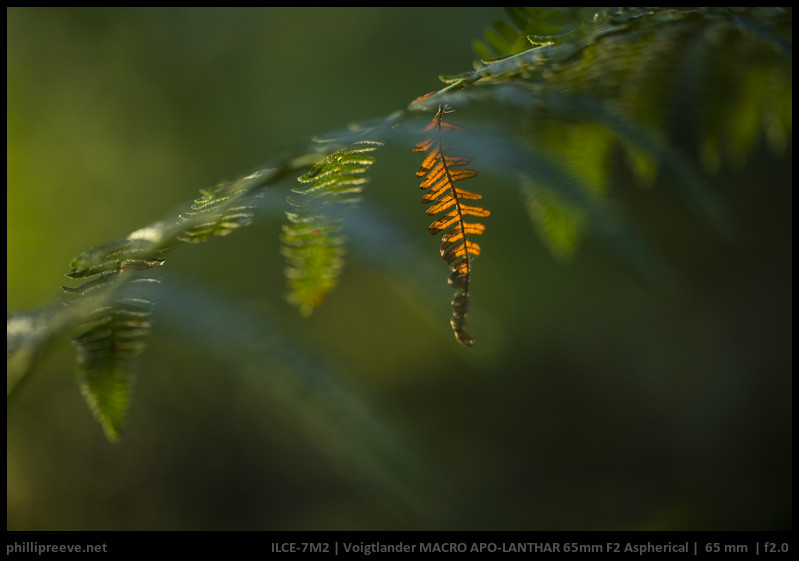
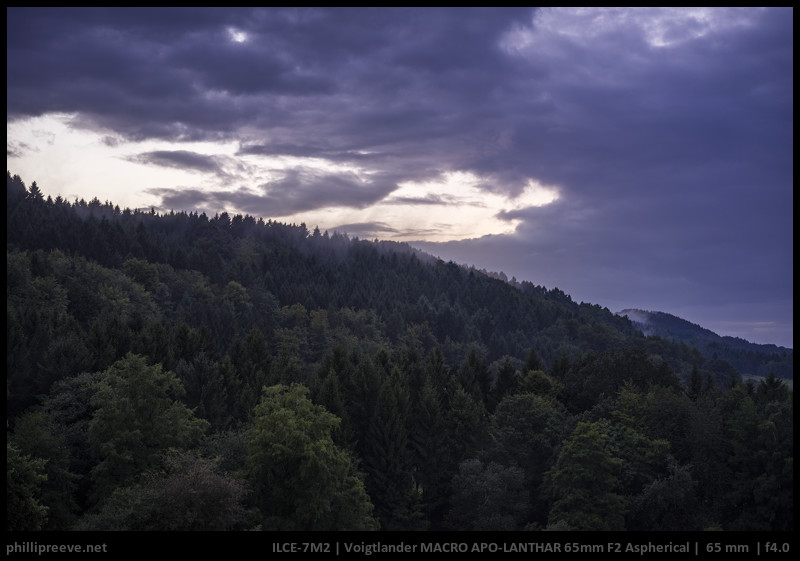
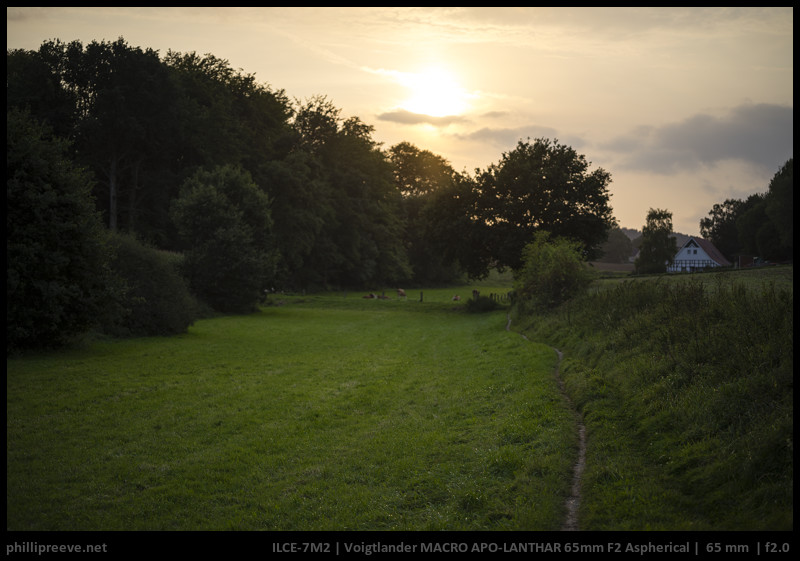
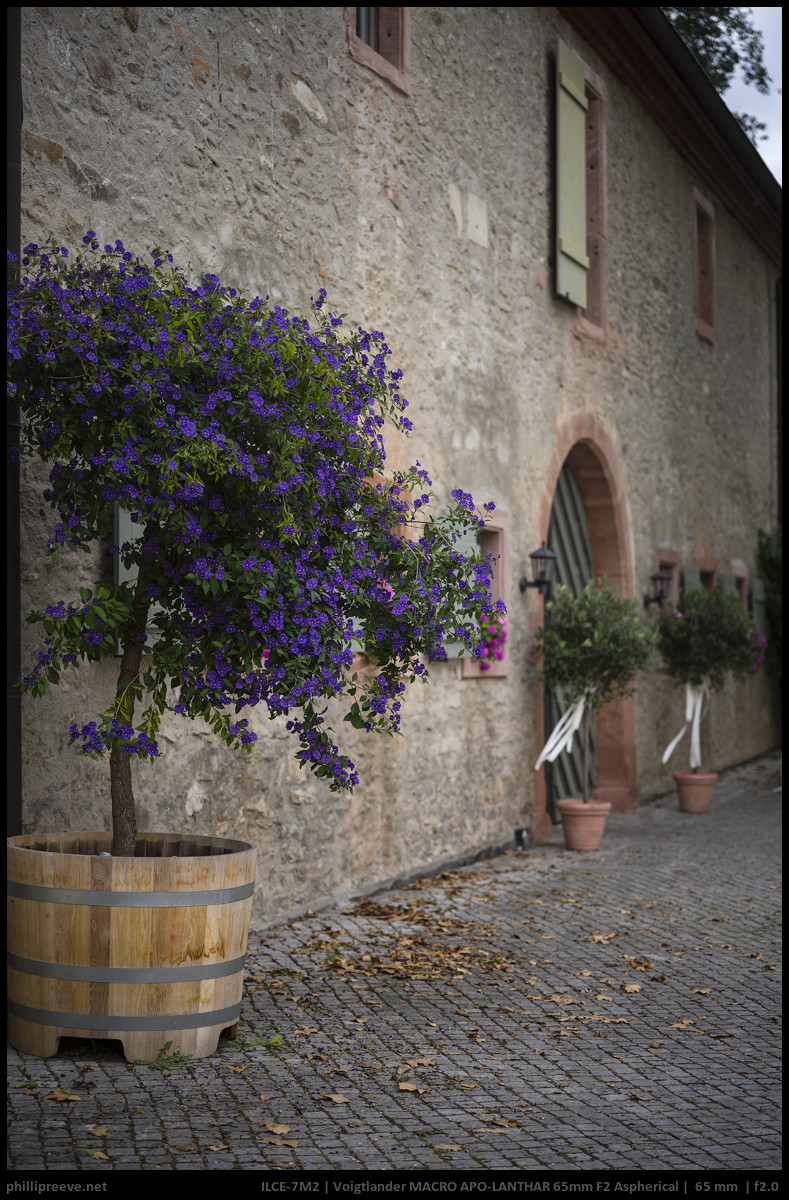
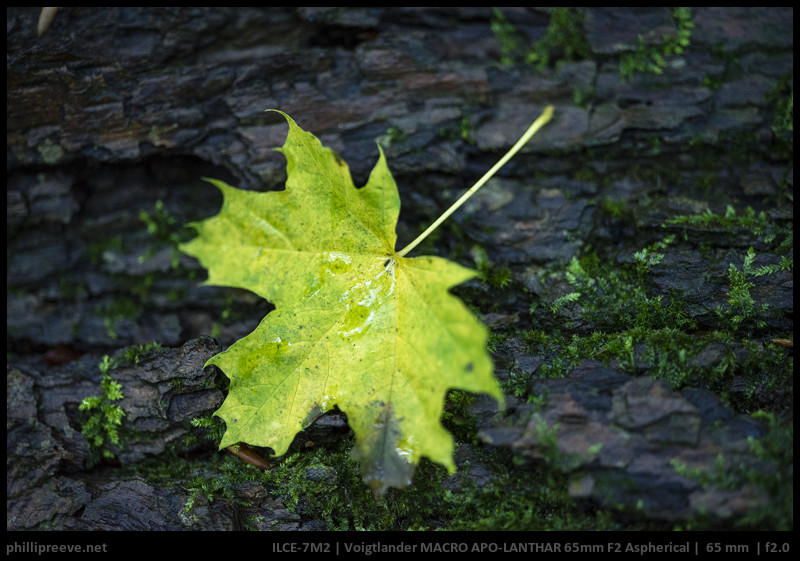
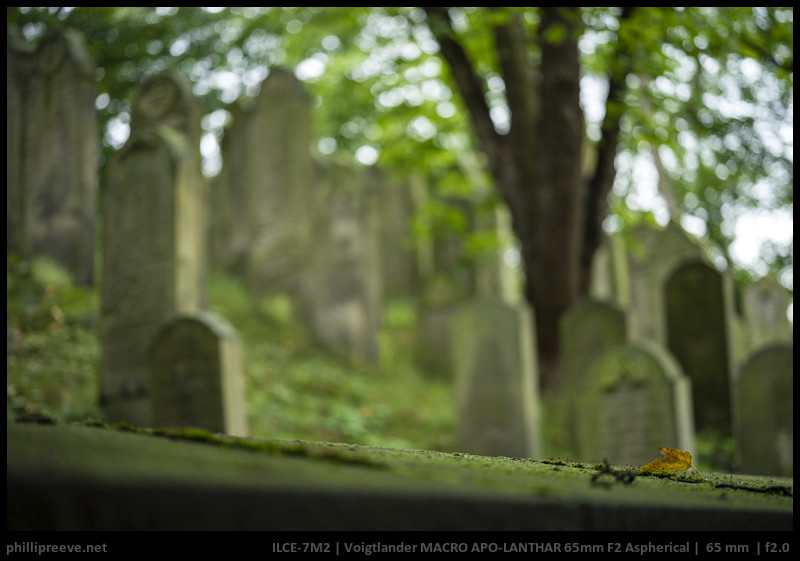
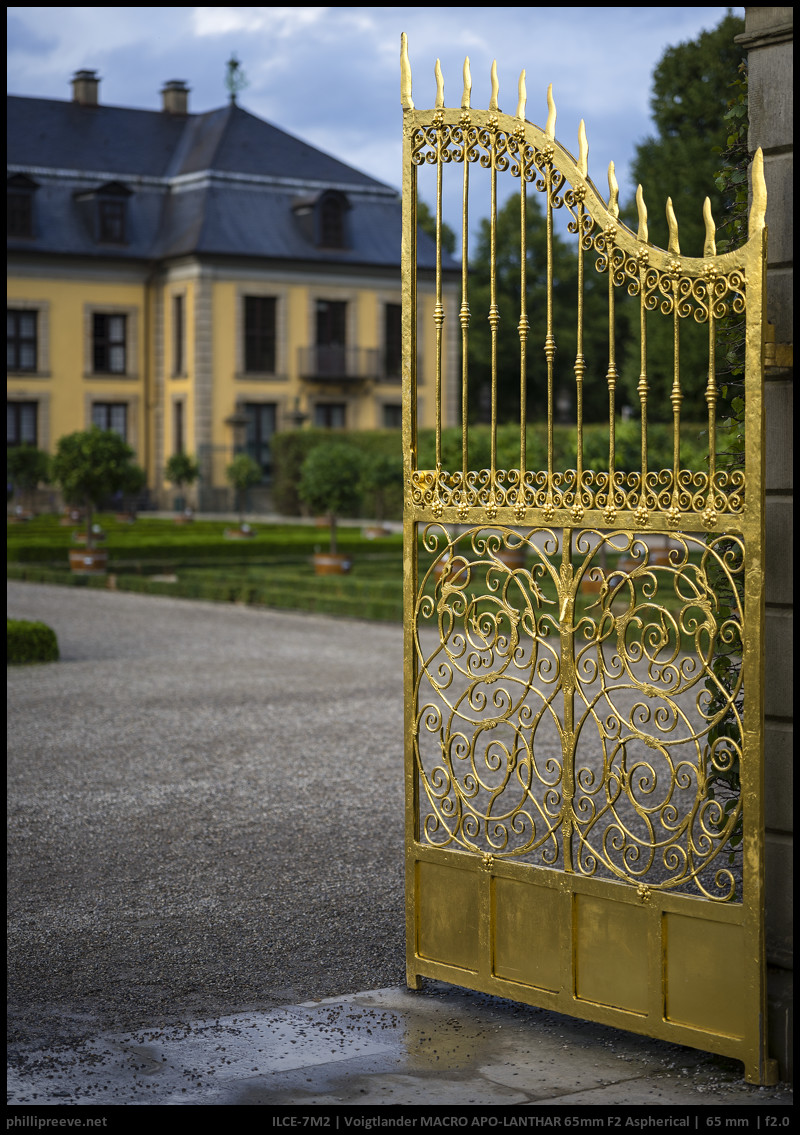
You can find these and more images in full resolution in this flickr set: Voigtlander 2/65 APO.
Other articles
- Voigtlander Ultron 35mm F1.7 Review
- Sony FE lenses: A comprehensive and independent guide
- The best lenses below $499 for the Sony a7 series
This site contains affiliate links. If you make a purchase using any of the links marked as affiliate links, I may receive a small commission at no additional cost to you. This helps support the creation of future content.
Latest posts by Phillip Reeve (see all)
- Review: Samyang AF 75/1.8 FE - April 12, 2021
- The FE-List now has 113 lenses on it - March 25, 2021
- 2020 – Year’s end review - December 28, 2020


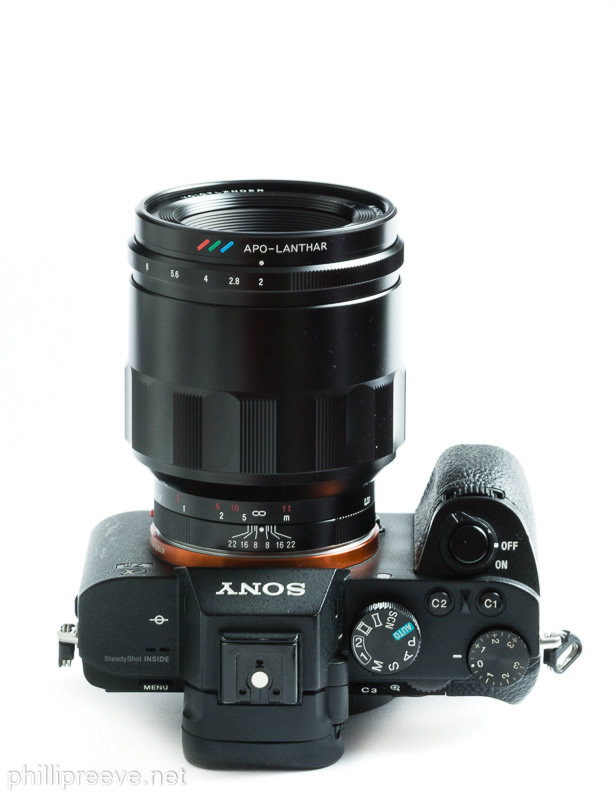
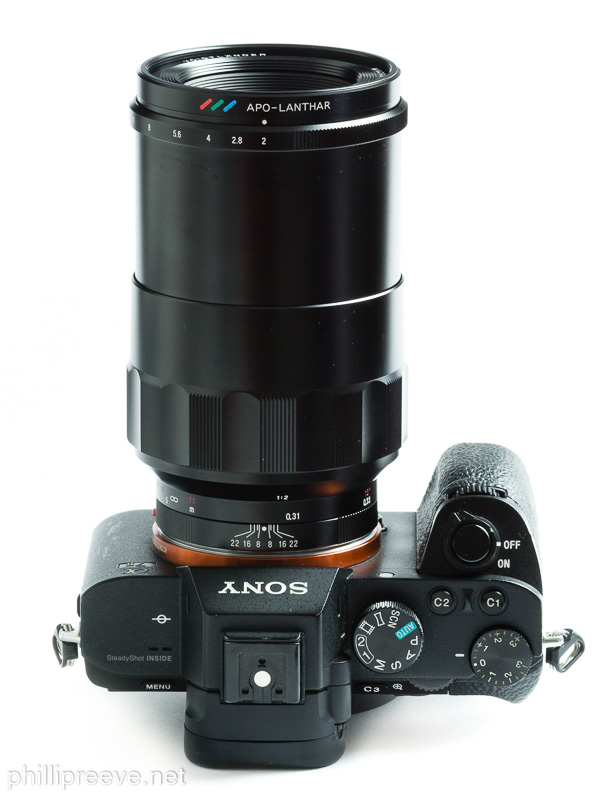
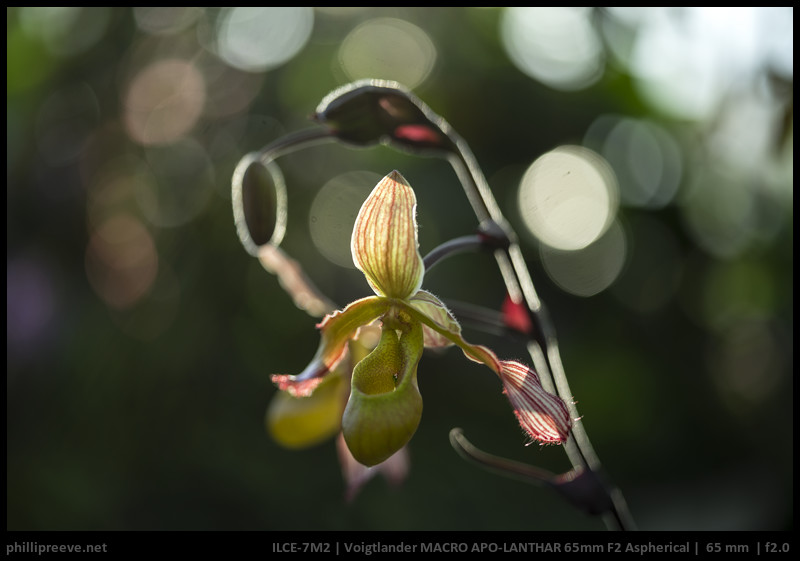
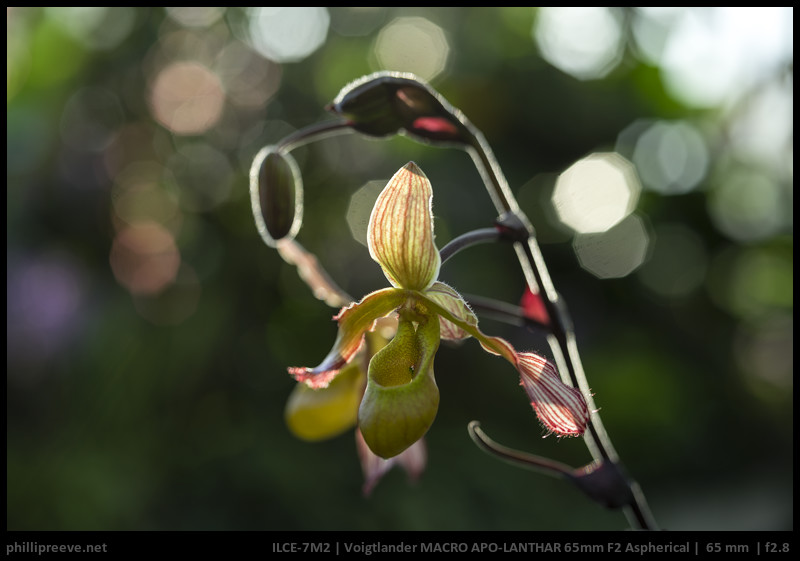

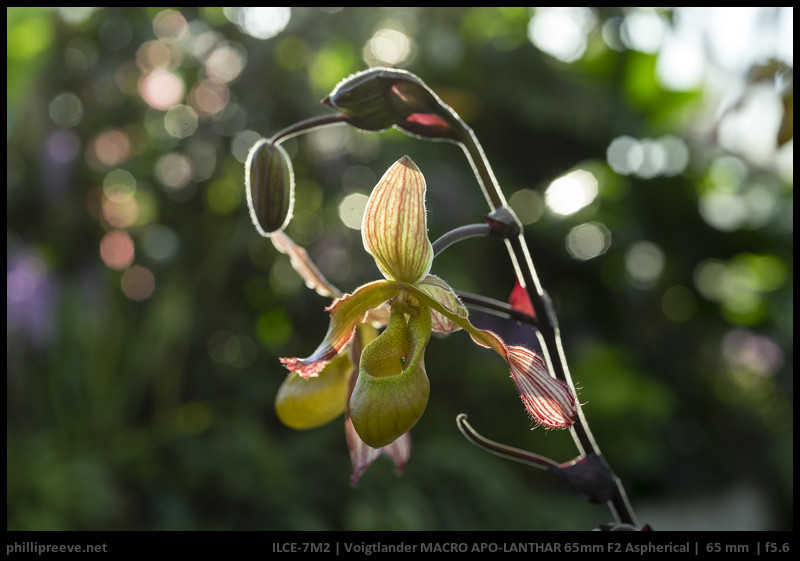



That’s some pretty incredible results. If it was a 90mm F2 I’d start saving up for it immediately. If it was 50 or 55 I might consider selling my just acquired Loxia for it. I’m not sure I’d find much use for the odd focal length though. I’ve used a 35mm lens on my Olympus E-M5 (which is reasonably close at 70mm) and I’m not sure I’d like that focal length, especially since 50mm is my favorite focal length. I suppose my Vivitar Series 1 90mm F2.5 will have to make do until a macro I really like is released at that focal length.
The focal length is something I will certainly have to learn to live with but so far it has worked well for me.
I’m sure you’ll get some incredible results with it. If budget allowed I’d probably get it as well. I already spend more than I should on photography though.
Who didn’t…
I have been debating between this lens and the 75mm f/1.5 Voigtlander. I have just read your review of it also .
I myself like the 65mm focal length and k ow this because I own the Sigma 65mm for my Sonys . I’m wanting this in the Z mount for my Z9. It is my favorite camera to manual focus on, ever! I’ve shot manual focus since about 1973ish . The Z9’s focus peaking is phenomenal.
I was wondering how easy it is to hit focus with this 65mm f/2.0 . I’ve been looking at the Voigtlander 75mm f/1.5 also and see folks saying it’s difficult to hit focus consistently with it . On my Z9 I shoot live music with the Nikon 135mm f/2.0 wide open and get great results. Also I use the Voigtlander 40mm f/1.2 in the same conditions at f/1.2 with great consistency. That’s why I praise the Z9 . I cannot get those results on the Sony a7siii’s I have .
Obviously it is easier to hit focus with a 65mm 2.0 than a 75mm 1.5.
I don’t think either is harder to focus than a manual 135mm 2.0 though.
The 65mm 2.0 and 75mm 1.5 are completely different lenses, really depends on your needs which would be the better fit.
Hallo Philipp,
thank you for your effort testing the Voigtländer 65 f2!
Would you mind to include some portraiture photos of humans at f2 ? (This could help to evaluate the lens for portraits)
Thanks,
Reinhard
I will try but for privacy reasons I don’t publish pictures of friends and family and I don’t do model shootings so my opportunities are very limited and usually I end up with portraits of sheep or ibex 😉
Could we get some more macro photographs and comparison with alternative lenses, especially Sony FE 90mm F2.8?
How about old Contax Zeiss C/Y lenses?
I added a few macro samples and also ran a short comparison with the FE 2.8/90 which you can find in the flickr album. The are similarly sharp. The Voigtlander has no CA, the Sony some. But the Sony has the smoother bokeh.
Can the Voigtländer this too?
http://imgur.com/a/P30Rl
😉
Phillip, great review as usual. Thanks.
In your conclusion, a word is clearly missing on the second line after “very” – “…Voigtlander 2/65 APO is one of the very E-mount lenses…”
This meant as a private message. You can delete it afterwards.
Marc
thanks for pointing it out 🙂
Don´t forget the Sigma 70mm f 2,8… and it focus down to 1:1 with perfect sharpness and Bokeh.
Thanks for the tip, indeed I forgot it. Do you use one on a a7 series camera?
The Sigma 70 mm f2,8 works flawless on fullformat. It is though a bit “loose” in the focus ring for manual work, but it has autofocus that works just fine togeteher with a7mk2 and a7 r2. Sharpness excellent… one of the best out there. If You can find one, try it and compare it with this 60 mm…
Thanks for excellent work and the best of the best info on the whole internet regarding photo gear. I am also very impressed about Your layout and writing, – Less is More:)
Can you elaborate a bit on the handling? Which mount and adapter do you use?
And thanks for the compliment 🙂
Canon mount and Metabones adapter. Autofocus works pretty ok. The main problem is when You turn Your Camera on is that the lens focus from infinity to closest… but then it works ok. Of course if You have it on manual focus this doesn´t happen…
A other strange thing is that some examples can have a slightly yellowish tone…
I have used the lens several times for Magazine covers on 2.8 with excellent results. Sigma macro lenses are among the best if You ask me… 70, 105 and the 150 are very very good but heavy lenses.
Seems like it is a very affordable solution for those which are interested in excellent image quality and are willing to sacrifice some comfort over that. Thanks for your input, I will include it when I add the “alternatives” section.
Which one is sharper between Loxia 85/2.4 and CV65/2 in your opinion? I plan to get Loxia85 soon but this one came of nowhere and start to sway my decision a bit.
At first, I want CV 50/1.5 Nokton but I don’t like using adapter and non-exif data is quite problematic since I still in learning stage (I might need to review photo I take) that’s why I drop it and start to looking at Loxia.
My main purpose is portraiture, Thanks.
I would have to compare them directly to know, both perform on a very high level. Check this link out: http://www.fredmiranda.com/forum/topic/1504525
WOW! Thanks a lot. 🙂
I have compared them (and started the topic that Phillip was kind enough to link to). I don’t think there is a sharpness advantage between the Loxia 85 and the CV 65/2. Buy one or the other (or as in my case, both) based upon focal length and drawing style. Also, the CV is more versatile due to its macro capability, but both are extremely well corrected optics that are sharp across the frame from wide open. We are increasingly spoiled for choice with Sony E mount lenses. The Voigtlander is also fatter than the Loxia (67mm filter thread versus 52mm for Loxia). Both are A+ lenses.
thanks Stephen 🙂
Thanks a lot, Stephen.
If You are interested of some test pics from a Sigma 70 f2.8 just let me know. I can easily photograph some in my Backyard (field and forest in Dalarna, Sweden) based on how You normally test Your lenses… You can have jpeg´s and raw if interested.
Normally I work daily with Canon EF lenses, (some Sigma favourites like their macro lenses and the 50 f1,4 art) on Sony A7 cameras since I have felt in love with their sensors, -but still find my Canon lenses better then many others….
Just let me know to whom I should send the pics!
That would be great, could you maybe upload some full resolution files to flickr? If that is easier I could upload them for you on my account. Thanks 🙂
The Leica R 60/2.8 Macro may be a good alternative. Also 1:2 Macro, manual focus, close in focal length and aperture. A really impressive lens from mfd to infinity. I’m very interested in the Voigtländer and maybe replace my Leica with it. If you guys want to to a comparison, I may lend it out.
I own the Leica Elmarit R 60mm f2.8 myself since yesterday and I am also really impressed by the image quality in both macro and normal use. With the macro adapter I can reach 1:1 magnification!
Just wanted to ask, does it hit infinity focus exactly at the hard stop? Thanks.
It focuses slightly behind
How about the Olympus OM Zuiko 50/2 macro as a potential alternative?
Sure but unless you get it very cheap I don’t think it is a very attractive alternative.
I use the Olympus OM 50/2 (analog) on the Sony A7 and
am very happy with its performance in sharpness and bokeh.
But cant compare withe the CV 65/2 (what is propably better)
Thank You for the good review!
The Oly OM 2/50 macro was probably the best lens I used when I had OM film gear. I expect it holds up well, and if it’s not as good as the CV 2/65 you at least get the benefit that it’s a lot lighter!
Wenn das Teil auf Unendlich schon am 24MP-Sensor wahrnehmbar weniger Schärfe zeigt, als das 90mm von Sony, dann sollte das dringend an der A7R2 überprüft werden.
Zwei Linsen, die ich gerne im Vergleich sehen würde, sind die Rokkore 1.2/58 und 2/85
Tut es aber nicht.
How does this compare with milvus 50 (or 85 if you have worked with that) from an IQ perspective. Guessing based on review that
Milvus has better flare resistance and maybe better bokeh quality
APO-LANTHAR has better control of chromatic aberration
Difference in sharpness likely negligible in real world use at f2 and f4
Real question is 3d pop and color rendition for me. Can APO-LANTHAR play in same league as Milvus for these characteristics.
*Note – I am not asking for a precise technical performance evaluation between the lenses. Asking for your opinion / impression because you have used both.
I think the lens plays a much smaller part than processing in these aspects than and I used the Zeiss only for a few weeks so I find it hard to give you an answer, there is no significant difference in my eyes.
Great review like always, but it could be great to not post slug pictures, I find it absolutely disgusting… cats and squirrels are better 🙂
I would change it for a cat any second but I don’t have one, sorry!
Excellent article. I’ve been curious about this lens since reading about it’s release. I have the Sony 90mm macro, so your alternatives section is especially helpful. I’ll probably stay with what I have, but always interesting to read about other high quality lenses.
Any chance you could do a comparison with the Leica R 60 macro?
There is actually a chance but certainly no guarantee 🙂
Great review Phillip! I’m looking forward to the Sony 55mm comparison to this lens! I keep bouncing back and forth on which one I want to pick up LOL
Drooling for this. Your reviews often make me want a new lens, but this is worse than usual. I’ve been wanting a shorter than 90mm macro that I love (at 90 I would prefer the Tokina or the OM 90/2 over the Sony 90, which I also own but don’t use any more). At 50 for macro I’m using the OM 50/2, which sometimes has some very lovable character, but sometimes that character seems more like flaws. I’m looking to replace the OM50/2, but it’s been hard to say what could really replace it until now. 65 is maybe too long to replace it? Hard to say.
This focal length isn’t all bad. I was in Iceland for the last two weeks of August, and I had brought a Contax C/Y 35-70 zoom, which got wobbly and unusable on the trip. No problem, using 35 and 50 primes instead, but some days I found myself missing the 70-ish end of that zoom, which really would have been perfect. I didn’t have a prime to cover that. Hard to say if a somewhat heavy macro lens would have made the cut for that trip though. I didn’t choose to bring any macro lens with me, and weight was certainly a consideration as I packed my lenses.
I have Sony FE 90mm f2.8 G macro oss and I love it. But this lens,Voigtländer 60mm f2 offers more flexiability,because You can use it for macro,landscape,portrait and general pictures. 60mm is also easier to focus handheld than 90mm, the focusing are great with these Voigtländer.
Some times 90mm macro is to long and you need 50-60mm macro, so I Will buy this lens and keep the 90mm macro because I love it too. Thanks for the review!
You are welcome 🙂
It’s more than I’m usually willing to spend on a lens, but this would be a great companion to my Voigtlander 35mm f/1.7 Ultron VM. 50mm is too close to 35mm for me to carry them together in a kit, and the jump to 85/90mm often seems like a bit much.
Would you kindly address if this lens is a “flat field” lens. I would be using it primarily to copy artwork. Thanks very much!
It has a very flat field
Thank you!
To me, the obvious alternative is the Voigtlander 58, f1.4 for Nikon. If your adapter has electronics, it also transfers exif info. Much less expensive and a brilliant lens. Not macro though.
And optically quite inferior but sure for man appplications results will be close enough
Have you handled the 58mm? It is brilliantly sharp from f2.8 to f5.6 corner to corner. Sure the corners are nothing at f1.4 and only a little better at f2. I think the 58 is better at flare resistance. Still, I might agree with you if I had the 65 to compare and was comparing full res images. I have not handled a copy of the 65 yet.
I haven’t but I have read reviews and it a classic double gauss design although a good one.
I have the older version of the 1.4/58 for Nikon. It’s a nice lens, but not really that much better than the Nikkor 1.4/50 AIS. Comparing it to the 1.4/50 Sony, Sigma or 55 Zeiss Otus should show a very obvious difference (I don’t own any of those). The Lanthar, however, is Otus quality for 30% of the price. And EXIF data to boot.
Have you tested the Voigtlander 90mm f3.5?
I haven’t
Hard to compare, as these are very different focal lengths. The nice thing about the 3.5/90 Lanthar is its small size. Even with a Nikon F to Sony adapter, it feels much smaller than the 2/65. The 52mm filter thread is nice too (especially if you happen to come from Nikon). But its maximum magnification is just 1:3.5, which is too far from macro territory for me. For vacations, I used to take a Nikkor 2.8/24, the 3.5/90 and a Nikon 4T close-up lens, and was quite happy with the results. Optically, while good, it is not as good as the 85 Loxia or the Sony macro, and far from the 2/65.
Hi Phillip, thank you for this review. The lens being 625g, I am curious as to how lighter or heavier it actually feels wihen using. For example, SEL100F28GM makes a magical impression as though it were much lighter than its real weight (700g), or at least, it did not make me feel drained by weight. In comparison, SEL1635Z being 518g feels quite heavy to me when attached to the camera.
I always enjoy your articles and like the way you express in writing as well as photos.
Well, hard to quantify. It weights about as much as my Sony 2.8/90 macro but feels more dense because it is. Does that help any? 😉
Thank you, I can tell what you mean. The feeling may be related to the material used and the balance of the lens.
Fantastic review! Very interested in this lens now.
Can someone please tell me if the electrical contacts on Voigt 60 f2 activate the focus assist (as the loxias do).
Thx
They do
Good review, seems like a very nice lens for a number of scenarios.
65mm is an interesting “middling” focal length, f/2 is useful, good sharpness at infinity and nice sunstars.
I like my clinical “dust-sucker” 55 2,8 ais but it would be interesting to try this Voigt one day.
This is a comprehensive and balanced review. I purchased this lens within a week of its release merely because I like its field of view (like a 50mm on my old Leica M8.2). I agree with all of your results. One additional thing I notice is the vibrant color from this lens. I find that I need to apply much less post processing to images from this lens, in fact, settings that I use for other lenses tend to over saturate images from this lens. Have you noticed this too?
It certainly has high contrast and saturation
Have this lens since a couple of weeks now and noticed the same.
great review as always! Looks like a great lens. I was wondering how close a loxia 85 and extension rings would come in image quality vs this lens for macro? Thanks
This article contains some shots I have taken with Loxia 85 + Kenko extension tubes.
The Loxia is an extremely high resolving lens and holds up quite well with extension tubes.
Nevertheless, I doubt it is a match for a real macro lens at a magnification of 1:2,
furthermore there is of course some lack of flexibilty when using extension tubes.
If I may ask, given your usage up until now, would you recommend this over the 50 loxia? I have the loxia and while I like it, I’m finding the new 35mm 1.7 ultron to have better bokeh although the color signature is a bit more muted- which I quite like. This looks to be better in every way minus the odd size and FL.
Better in every way minus size and FL characterizes the CV65 well so for most uses I would recommend the CV65 over the Lox50.
Would you recommend it over the Sony ZA 50mm 1.4 ?
It is technically a better lens but the FE 1.4/50 has AF and a stop more so they are a bit hard to compare.
OMG !! Even better than the 50 1.4 . I am going to definitely get the 65 and Sony 85 1.4 or maybe just dismiss the 85 and go for the 135 2.8. And the 21 loxia 2.8.
Thank you for your article.
I would like to know if Voigtlander e-mount lens included dust proof or something like that.
Not that I am aware of.
I find the focusing ring too loose on this lens. First, the lens focus is twitchy — near infinity focus, turning the ring by even one degree can result in a soft image at 42 MP. Second, the lens’s internal tube is very heavy and full of glass. Consequently, if I touch or move the lens slightly, (e.g. for a handheld panorama), the lens can go out of focus easily. I would prefer slightly more damping or some kind of set screw or lock.
Too loose? Hmm, do you have the chance to compare it to another copy? Because while I agree that tarnsmission is steep at longer distances I found the resistance to be very pleasant.
Thanks for the great image set on Flickr for this review. I just purchased this lens and have really enjoyed it so far. It’s double the weight of any lenses I have owned, but otherwise it’s super in all regards. With that said, I never take it anywhere 😉
That sunstar is amazing… nothing compares at this focal length on any format, AFAIK… wow!
How does it rate in terms of coma?
Bought this lens and so far it is epic! Don’t know what I’ll do with my loxia 50…for now I’ll hold on to it. Bokeh on the 65mm is quite nice and the sharpness is stellar wide open. I especially like the knurled focusing ring and placement of aperture ring in front. I thought the size would be a bit to much at this fl but so far no major bother.
Now it’s time to save up for the rumored 125mm f2 next year!
I don’t think they will release a 2/135 APO, much more likely a 2.5/135 but I look forward to that none the less.
True. It was a rumor online a few weeks ago- that they are working on one. Hope it’s true! Cheers.
Many thanks for your great detailed review. This lens sounds good to me, ‘cept for the 65mm bit. Not a macro shooter, and I’m not sure what to do with that focal length.
What did you find yourself shooting with this lens? Portraits? Landscape? Macro? Thank you.
A bit of everything. The samples in this review give a good impression of what I use it for.
Thanks. Just wanted to check if you ended up using the lens in a particular way beyond what I saw on this page. Cheers.
I just bought my own copy a few days ago so I had little chance to use it since finishing the review.
Ok. Thanks again.
What disturbs me al lot, in case of repair service etc. every Voigtländer lens must be send for repair back to COSINA in Japan! Why is that?
A pro using a Voigtländer glass cannot wait a couple weeks to get his lens back from repair! This is an very negative issue!
Thanks for the review. The lens looks great and your shots looks great too.
There is just one thing I did not like: The highlights in the background look awful on that shot of the orchid because the lens does not have rounded aperture blades. Even at f2,8 they have strong edges. I own the 40mm/f2 and the 90mm/f3,5 for Nikon and these lenses have perfectly rounded blades. I cannot understand why they did not include them in the 65mm/f2.
They use 10 straight apertures in all their E- and M-mount lenses which are great for sunstars but as you noted they have some detrimental effects on the bokeh.
I am really curious what will be the result of a head to head comparison with FE 50 2.8, AIS 55 2.8(an old Japanese made copy) and maybe the Zeiss 50 2.0 Macro (Milvus or the older one).
Awesome review! You convinced me to sell the FE 55 1.8 for this, and over the 50 1.4, mostly due to price and weight. I’m not sure if I’ll be keeping the 90 2.8 after this, but we’ll see!
Hope you like it as much as I do.
Thank you for another great review! Odd that you would list it against a 100 makro-planar as an alternative when it’s probably closer in spec/size and performance to the 50 makro-planar. Which after this review I think I still prefer because of it’s color rendition and contrast over the Voigtlander.
Hey there Phillip, thanks for the great review on this lens. It guided me towards purchasing my first Voigtlander. She’s a real beauty.
Hi Phillip, thanks for your detailed reviews of many lens that I read here already!
I am interested in which programs you like to develops raw files? And what you think about color rendering in this programs? Especially I would like know that you think about Capture One, Lightroom, PhotoNinja. Which one do you prefer?
I have used Lightroom for many years now and since I am quite happy with it I haven’t bothered with testing other programs. Regarding color I usually do very little about it. I think nice light when taking the image is much more important than lenses or the raw converter.
Phillip, I wanted to say thanks for the really great articles that you, Bastian and Jannik provide. Really, the best I have ever seen. Here is a link to a video review of the Voigtlander 65mm F2 that I also very much appreciated. I know you guys already do so much but a video review from the guys at phillipreeve.net could be pretty special. Just a thought…
https://www.youtube.com/watch?v=-vCch9HDk4A
Video reviews are something we already thought about, but none of us is profound in cutting and editing videos and so far no one external volunteered to take care of that part for us, which isn’t really surprising 🙂
I, for one, much prefer a written post like this over a video review. This way I can read the review at my own pace and examine full size pictures at my leisure. Video reviews are time consuming, inflict horrible compression artifacts on image quality, require audio, and make it difficult to search for particular pieces of information.
Same is true for me and I would not want to do video instead of our usual reviews, I would see it more as an addition.
Something in the way of the short-lived digitalRev AnalogRev videos by Ian: going out some place with only one lens and camera, taking some shots, showing nice scenery and a few pictures taken during that time (which could then be found in the full review anyway).
But this is obviously a lot more work than just Lightroom recording with almost no cuts.
Try the new Sigma 70 mm 2,8 macro Art. It is even better then the old one, and works really well on Sony A7 series. Autofocus slower then Sony lenses but accurate, and in manual mode “slow”, but that makes life easier to “nail” exact sharpness.
Almost no bokeh fringing what so ever and sharp on f2,8 all over even on 42 mp. Descent bokeh and If we consider the price then it is a bargain.
Hi Phillip and not only thanks for the review, but thank you for inspiring me to get into the world of manual lenses!
That said, I ordered a cheap Minolta MC 50mm F1.4 for my A7Rii and absolutely love it! And most of all, love using the manual focusing technique with the assisted focus on the Sony. I’ve noticed that I’m able to grab focus faster and enjoy shooting pics even more this way…
However, I do own the Sony 90mm F2.8 macro and do like it a lot! But this Voitlander is making me reconsider my original purchase and sell it to get the 65mm APO.
I do enjoy the focal distance of the 90mm and I do focus on lots of stills and product photography. But now with the ease of faster focusing and artistic control, I do enjoy manual lenses much better…So in my case, would you still recommend the Voigtlander or should I just keep my Sony?
Well in terms of application the 2/65 is not a good substitute for a 1:1 2.8/90 macro but sure it could be more enjoyable to you.
Honestly between the CV 65, the Sony 90 and probably the new 110 I’d go by focal length and magnification.
The Sony 90 is very good at ordinary distances, but it is the best short tele I’ve ever used at 1:2 and closer. I expect the CV to be as good, and the 65 is about as good at 1:2 but has no 1:1.
The linear MF mode of the 90 (using the clutch) might not feel as nice as a helicoid, but it offers just as much speed of use and precise control, so I don’t think there’s any practical reason to prefer the new CV beyond FL. Of course you might prefer the brass precision feel of the CV but that’s up to you.
Close to 1:1 all of these lenses allow you set magnification on the lens, and then move the camera to focus, which is the preferred method really at these distances.
I’m also obsessed with ture APO lens and own a APO lanthar 180, truely a gem.
I’ve also heard that the new Sigma 70mm f/2.8 Macro ART (half native FE mount though) also has exceptional chromatic aberrations control. Although it’s a stop slower but from this review: https://dustinabbott.net/2018/09/sigma-70mm-f-2-8-macro-art-review/ I’d say it’s probably on par with Voigtlander 65/2 and it looks better than sony 90/2.8 macro. I’m wondering if you may have any chance to test the two against each other.
Not likely to happen but I would say that it is safe to assume that the Sigma will come close.
What is the working distance from the front of the lens at 1: 2 magnification
Guys, I take this opportunity to congratulate you all on the great work, quite inspiring. Strictly regarding the CV 65, I was wondering whether there are any solutions you have tried to increase magnification to closer than 1:2 (tubes/filters)?
Well I bought the 2.5/110 but that isn‘t helpful to you 😉
(Sorry was meant to be a reply to this comment)
Hi Philip, how have you found the APO 110 compared to the 65mm & Sony 90?
It fits better into my kit which usually also includes the 1.2/40. Still enjoy every aspect but the weight about it. For the G90 I liked handling less and the 65Apo often wasn’t used because I usually grabbed the 40 first.
Thanks for the fast response. Ok I’m really wanting two lenses at the moment. A great macro (it’s spring in Australia and a lot of my vineyards have potentially great shots), a portrait lens (thinking gm 85) or nice manual lens with great sun stars.
So your enthusiasm of the APO 65 has dulled a little since writing the review? Prefer the APO 40….
A the Flickr samples downsampled and compressed? The samples where a bit underwhelming such high praise, in general.
Hello Phillip, I recently purchased for my a7sii and something i’m not used to is happening with the lens on my camera and you dont mention it in the review above. when i attach the lens to my camera and turn it on the aperture on the back of lcd changes on its own as I move the camera around, i dont know why its doing this, its as if the camera is on shutter priority and the aperture changes according to exposure i guess. I have the camera on the M dial and the aperture is set manually to f2 and when i move it around to lets say focus on a building, the aperture on the back of the screen jumps around even though its at f2 on the lens, did your copy do this?
Not sure I understand your question but you have to set the aperture on the lens. The camer cannot change it.
What shouldn’t happen is that the displayed aperture changes even though it hasn’t been changed on the lens.
basically that is whats happening, the lens is at f2 and the picture on the lcd is at f2 but the data showing the fstop on the lcd changes on its own but doesnt affect the image in any way, just the infomation diplayed, its like the camera cant read the exif data coming from the lens. i did try cleaning it and still does it, so i was wondering if yours did it also. i have a video i can show you if i can share it
Thanks to this review I now own the V’lander 65 Apo-Lanthar, though patiently waited for pristine used offering.
Phillip, I like the screw on lens hood. Keeping it mounted over a CPL, and for wildflowers and plants in sidelight I often attach this combination. Better to have filter surface shaded by the hood, and convenient to be able to twist the hood to trim the CPL.
Voigtlander and Cosina must have been thinking of me when they designed this.
Keep up these excellent reviews!
Hi Phillip, Thank you for your review.
Do you like its’ portrait shots? background blur, skin tone and…
I bought this lens but I have a problem. I expect almost zero CA. All tests say that. I took several photos and… some of them have plenty of CA. Branches on the tree are purple. What do you thing about that. Is it normal ? My lens is new. I can send you examples.
IF you see plenty of CA then there is something wrong with your copy.
I asked professional photographer in Poland (http://mactaichman.eu/) if there is something wrong with my lens. Everything is ok. He explained me how something like that could happen. Thanks
Dear Philipp great report. I like it! Perfect.
KR Wolfgang
Dear Phillip,
I bought the lens because of this review (after I read it maybe five times) and finally did not regret.
The lens delivers with unbelievable sharpness, micro-contrast and colour rendering.
Thank you for your efforts keeping this valuable site running!
Ortwin
“If you have used Zeiss Loxia lenses you will probably have been frustrated by the fact that there is no good place to grab them when you change lenses.”
You just grab the focus ring and rotate it fully. Zeiss recommends it.
Thanks, Phillip…no doubt this is an incredible lens but is it worth my money to sell my Milvus 50/2 Macro to purchase the CV 65mm?? Mind you, I already own the 35 & 110 CV APO’s and they are remarkable.
Hey Al,
I’m using the Voigtländer MACRO APO-Lanthar 65mm F2 paired with the Voigtländer NOKTON 21mm F1.4 as my standard two-lens hiking kit on a regular basis (the mfd of the CV 21 allows for nice wide-angle views embracing subjects in the foreground despite being a non-macro lens — slightly stopping down (to F2 to F2.8) yields to very nice bokeh in those situations as well). Both lenses are also incredibly well performing when it comes to stopped down landscapes.
Before having the CV 65 I often used an old Minolta 50mm F3.5 Macro. This little old lens performed pretty well — considering its age –, but the performance/perfection of the CV 65 is of course from another world!
Personally, I think the look/field of view of 50mm and 65mm lenses is rather similar despite their difference in focal length. I even tend to like the look of the 65mm a bit more than the look of 50mm. The CV 65 delivers a nice “hint” of compression in depth like a (very) short tele lens would do without sharing the (for some applications) too narrow field of view.
Whether 50mm or 65mm are the better choice for you still is up to your personal taste, I guess.
The CV 110 on the other hand is a true tele lens and delivers the corresponding look (true for macro use, too). I would also love to have/use this lens, but I already own way too many lenses of focal lengths around 100mm — including the Sigma 105mm F1.4 DG HSM Art and the Sigma 105mm F2.8 DG DN Macro Art (a stellar performer with also APO-like qualities) — to justify the CV 110.
Having used the CV 65 and the Sigma 105mm Macro side by side on a trip I don’t expect direct “rivalry” when pairing the CV 65 with the CV 110 due to the noticeable difference in focal length. But maybe I’d rather pair the CV 65 with a slightly longer 135mm/2.8 non-macro lens (e. g. the light and very sharp Minolta MD 135mm/2.8) and a wide-angle lens for trips with three lenses and not too much weight.
Greetings
Olaf
I use Sony a7r4’s pixel shift to copy large size paintings. Your review of Voigtlander 65mm F2 obviously interests me enormously. Do you happen to know if a7r4’s focus peaking work correctly/precisely with the manual focus ring of this lens? Thanks!
For your task I wouldn’t use focus peaking with any lens but rather magnify to get best results.
In July 2022 I replied to this review asking whether the CV 65mm would be an option over my Zeiss Milvus 50/2. Shortly after posting that question I did sell the Zeiss and purchased the CV 65mm. I wanted to report that my CV 65mm is just a phenomenal lens and though I was apprehensive at first about the trade must say that I have been very happy. The CV 65mm brings a lot of joy and paired with my CV 21mm /1.4 Nokton have been on my camera the majority of time. If I was going to sort through my gear for a lengthy trip abroad my bag would only contain these two lenses. As I said once before the CV 65mm is remarkable!
I’ve just been given one, and your excellent review makes me very exited to try it out on my A1!
Thanks for the great review